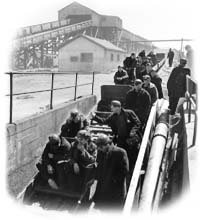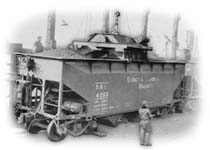



    |
|
|
Transportation
Transportation (railway) in Cape Breton was developed as a necessity for the growing coal industry in the area and a need to transport this coal to markets in central Canada and New England. From the mid-1850s on, thirty new mines had been opened within a period of thirty-six years. An efficient method of connecting these collieries together was established to make the entire industry more profitable. North Sydney was considered to be situated in a very good geographical location because it was the most direct line of travel. Being located on the harbour with the Sydney coal mining district adjoining eastwardly, it therefore played an important role in the trade and transporting of coal to Canadian and various other markets. Some historians believe the first railway in Canada to have been laid from the Albion Mines, Stellarton, to a point near Granton on Pictou Harbour. However, there is no doubt that before 1833, railways were definitely in use in Sydney Mines. Coal-laden wagons were hauled by horse on the road from a stationary engine. This would be done halfway and then the cars would be drilled down the hill to the pier. To carry the horses down hill, special dandy cars were attached to each train. By 1839 the horses were being replaced by steam engines because production reached such proportions that they could not handle the output. Other mining operations located near points where coal could be shipped, had built their own private railways. For instance, Lingan Colliery Tramway was one mile long and had a gauge of three feet, six inches. It was constructed from a mine to a wharf on the bar at Lingan in 1861. In that same year a group under General Strong obtained a lease for the Union Mine at Bridgeport . The group was reorganized as the International Coal and Railway Company under A.C. Morton who had been engineer with the earlier company. The new company proceeded with the development of the mine and the surveying for a railroad. 
Other mining operations were doing the same. For instance, in 1858, E.P. Archibald of Sydney obtained a lease for a coal mine in the Little Glace Bay area. Three years later the Glace Bay Mining Company was formed and operated two mines at Glace Bay and at the Stirling. In 1865, two 450-foot piers were erected on the west side of Glace Bay Harbour that had been dredged. A railroad approximately one mile long was built to connect the Glace Bay mine (Caledonia) with the piers. Later, a half mile was added between the Stirling and the harbour. Horses were still used at this time to haul the wooden coal cars to the piers. Later, a second railroad was constructed across the sand bar at Port Caledonia. The Ontario Mining Company, which operated a mine some two miles northeast of this site, assisted in the dredging of this artificial harbour. However, because the sandbar was exposed to ocean storms, the railroad proved impractical and the task of maintaining the line too great. During this time several newer companies formed, opened mining operations, and they found it necessary to develop some form of transportation system. In 1868, an English company known as the Glasgow and Cape Breton (Nova Scotia) Coal and Railway Company Ltd. was organized and authorized by the Nova Scotia government to build a railway from Sydney Harbour to Cow Bay (Morien) via Bridgeport. In 1870, The Low Point, Barrasois and Lingan Coal Company opened the Victoria Mines Railway. It was about three miles long and connected the mines with the shipping pier at South Bar at the entrance to Sydney Harbour. Also in the same year, 1870, a line 12.5 miles long was completed from Glace Bay to Sydney where there was a 100-foot pier on the middle harbour. 
In 1871, F.N. Gisborne, owner of the Schooner Pond Coal Company, associated with the Glasgow and Cape Breton Coal and Railway Co. Ltd. whereby a lease was obtained to mine the coal at Reserve. This lease required that a railroad be built from Reserve to Sydney, a distance of 10 miles. Two years later, in 1873, these two companies amalgamated with the Lorway Coal Co. to form the Cape Breton Coal Company. The railroad was then extended by a distance of eight miles to Schooner Pond. Next, in 1874, the company began construction of a railway to Louisbourg, about 21 miles away. However, due to limited capital, Captain D.J. Kennelly (England) immediately terminated construction on the line to Louisbourg and closed the Schooner Pond, Lorway and Emery Mines. In 1878, the property was sold at auction and bought by Kennelly who organized a new company called the Sydney and Louisbourg Coal and Railway Company (no connection with S. & L. Co.). Kennelly envisioned Louisbourg as a seaport with a great future as the terminus of transatlantic steamship lines. In 1881, his company took over the Glasgow and Cape Breton Coal and Railway Company. In 1877, Robert Belloni, organizer of the Blockhouse Mining Co. at Cow Bay 1864, took the lease of the International Coal and Railway Co. He conceived of the idea of a railroad from Bridgeport to Louisbourg connecting all the small mines operating along the coast, providing them with transportation for their coal both to Sydney and Louisbourg. A survey was done, but nothing more. In 1893, Henry M. Whitney, a Boston financier, merged all of the important coal mines into the Dominion Coal Company. Included was the old Sydney and Louisbourg railroad plus the International. On April 22, 1910, the Sydney and Louisbourg Railway Company was incorporated by an Act of the Nova Scotia government. It had been said, that Louisbourg had the busiest piece of railroad in North America. It handled freight, passengers, miners working the collieries, and mail. The line with steam locomotives and the Company kept these locomotives going as long as parts and service could be provided. By 1960 because of economic reasons and the unavailability of spare parts, twenty-nine (29) steamers were abandoned. In 1961, diesels came into service and, in 1966, the last steam engine was retired. Soon the availability of gas and oil reduced markets for coal and so, the link with Louisbourg was no longer necessary and the tracks were removed. In 1968, all operations ceased and what remained of the tracks later became the Devco Railway. |
|
The History |
The Future
Regional Impact | Mining Techniques | The Museum Main | Glossary | Site Map | Text Only |

Created by Virtual Media Productions Ltd., © 1997.
|